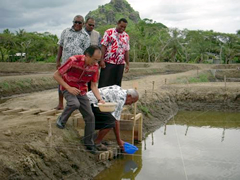Background:
The increasing number of recent population increase, food security is a high concern in Fiji. In the recent year over fishing by the increased number fisheries, use of destructive fishing method, etc the coastal fisheries resources are remarkably decreasing in many localities of Fiji Islands.
Due to the increased attention that has been given to the Milkfish fry resources abundantly appearing in the mangrove coasts of the northern Viti Levu (Biggest Island of Fiji), JICA was asked to provide its technical cooperation to verify a Milkfish farming industry as a new commodity development.

Releasing the Milkfish fry in the ponds
Milkfish is a traditionally being farmed in ponds by stocking with wild fry over hundreds years in Asian countries such as the Philippines, Indonesia, Taiwan etc however table sized Milkfish is rarely caught in the coasts due to its migratory characteristics.
Keeping all this in mind the Fisheries Department of Fiji together with JICA is planning to set this project as a leading light of Milkfish farming development in the country.
Project Period:
August 2009 till August 2011
Project Budget:
JP¥19.8 million (US$ 220,000)
Target Sites:
Vitawa Community, Ra, Fiji Islands
Target Groups:
The direct beneficiaries are people of the Vitawa community and technical skills transfer to the Fisheries Department's staff. Over 30 communities in the coasts of Northern Viti Levu Island with the population of 30 thousand potential beneficiaries, they will be provided with knowledge of Milkfish farming through the extension staff of Fisheries Department of Fiji.
Project Purpose:
Milkfish is produced in a sustainable way in the coastal ponds constructed at the adjacent Vitawa community in order to ensure household food security and it's verified as alternative livelihoods for the rural coastal communities.
Expected Outputs and Indicators:
-
1
.
Milkfish is farmed as a food fish.
Indicators:
a.) Construction of small scaled-fish farm
b.) Adequate numbers of wild milkfish fry collected by the community people.
c.) Production of table-sized Milkfish -
2
.
Milkfish produced is distributed periodically among the people of the Vitawa community
Indicators:
a.) Frequency of Milkfish consumed by the community people -
3
.
Economic viability of Milkfish farming is assessed through marketing trials and its business plan is formulated
Indicators:
a.) Cost-benefit analysis on the basis of Milkfish marketing trials





scroll